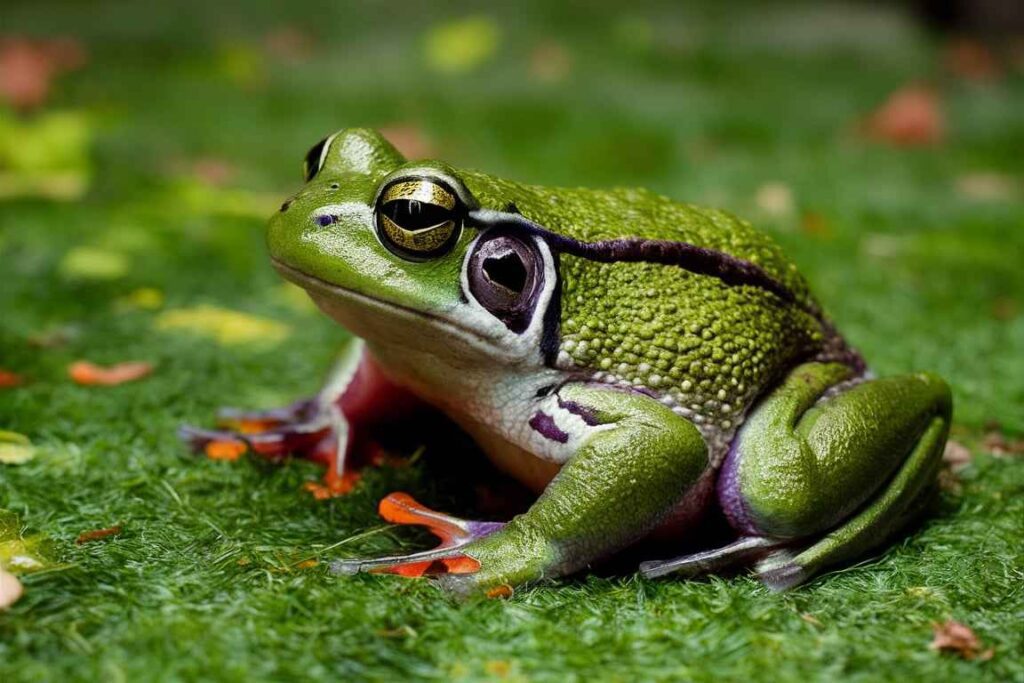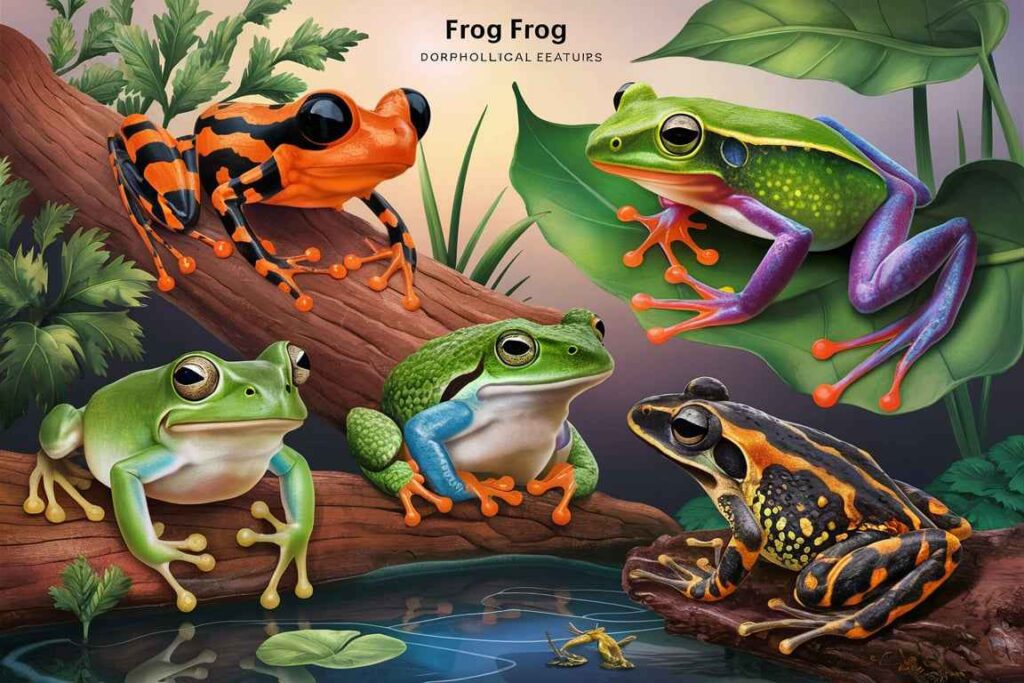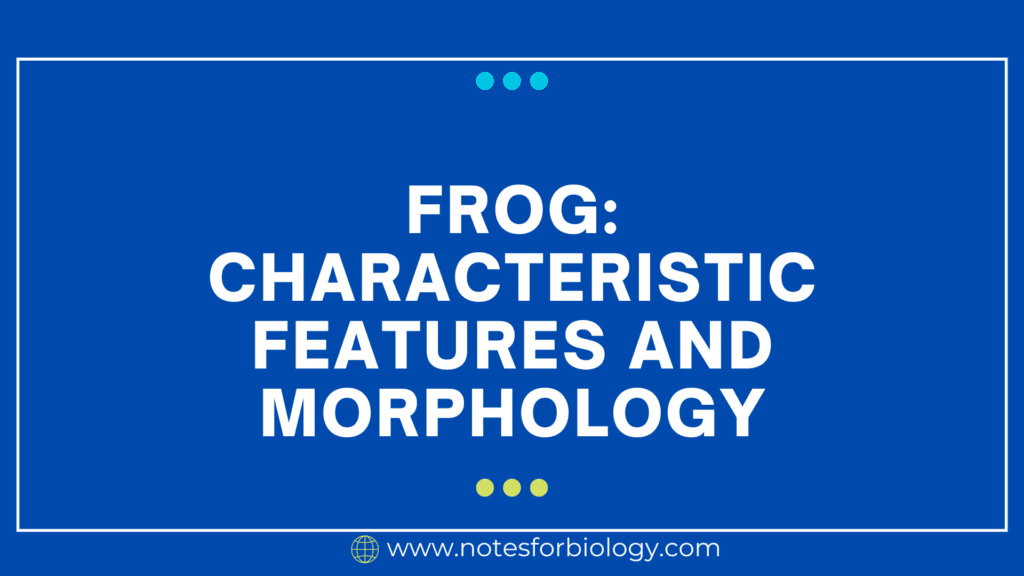Frogs are amphibians belonging to the order Anura. They exhibit a range of characteristic features and have distinct morphological traits that adapt them to both aquatic and terrestrial environments.
Table of Contents
Frog
Frogs are a diverse group of amphibians within the order Anura, characterized by their unique adaptations to both aquatic and terrestrial environments. These are amphibians belonging to the order Anura. They exhibit a range of characteristic features and have distinct morphological traits that adapt them to both aquatic and terrestrial environments.

Characteristic Features of Frogs
Amphibious Lifestyle:
- Habitat Flexibility: They can live in both water and on land. They are typically associated with moist environments but can adapt to a variety of habitats, from tropical rainforests to arid regions.
Metamorphosis:
- Life Cycle Stages: They undergo a complex life cycle starting from eggs, progressing to tadpoles (larval stage), and finally transforming into adult frogs. Tadpoles are adapted to aquatic life, with gills and tails, while adults develop lungs and limbs for terrestrial living
Respiration:
- Cutaneous Respiration: They can breathe through their skin, which is rich in blood vessels and allows for gas exchange. This is particularly important when they are underwater or during hibernation.
- Pulmonary Respiration: Adult frogs have lungs and breathe air, which is essential for their life on land.
- Buccopharyngeal Respiration: They can also exchange gases through the lining of their mouth.
Moist Skin:
- Mucous Secretion: Frog skin secretes mucus to keep it moist, which is crucial for cutaneous respiration and preventing dehydration.
- Permeability: Their skin is highly permeable to water and gases, which aids in respiration and absorption of environmental moisture.

Diet:
- Carnivorous Adults: Adult frogs are primarily carnivorous, feeding on insects, spiders, worms, and other small invertebrates. Some larger species may eat small vertebrates.
- Herbivorous Tadpoles: Tadpoles usually feed on algae and plant matter, though some species are omnivorous.
Vocalization:
- Communication: Male frogs produce vocal calls to attract females and establish territory during the breeding season. Each species has a unique call that can vary in pitch, duration, and pattern.
Reproduction:
- External Fertilization: Most frogs reproduce through external fertilization, where females lay eggs in water, and males fertilize them externally. The eggs hatch into tadpoles that undergo metamorphosis to become adult frogs.
Morphology of Frogs

Body Structure:
- Compact Body: They have a short, broad body that is streamlined for efficient movement both in water and on land.
- Absence of Tail: Adult frogs lack tails, a trait that differentiates them from their larval stage and other amphibians like salamanders.
Head:
- Flat and Wide: The head is large and flat, with a wide mouth adapted for capturing prey.
- Protruding Eyes: They have large, bulging eyes located on the top of their head, providing a wide field of vision and allowing them to see in nearly all directions.
Eyes and Vision:
- Nictitating Membrane: They have a third eyelid, called the nictitating membrane, which protects their eyes underwater and keeps them moist on land.
- Excellent Night Vision: They are primarily nocturnal and have excellent night vision due to their large, sensitive eyes.
Ears and Hearing:
- Tympanic Membrane: They have an external eardrum called the tympanic membrane, located behind each eye, which detects sound vibrations.
- Adaptation to Environment: Their hearing is adapted to both air and water environments, allowing them to detect calls and other sounds effectively.
Mouth and Tongue:
Wide Mouth: They have a wide mouth that can open broadly to catch prey.
Sticky Tongue: Their tongue is long, sticky, and attached at the front of the mouth. It can be rapidly extended to capture prey.
Limbs:
- Hind Limbs: The hind legs are long, muscular, and adapted for jumping and swimming. They typically have webbed toes to aid in swimming.
- Forelimbs: The forelimbs are shorter and used for support and feeding. They use their hands to help shove food into their mouths.
Skin:
Smooth and Moist: Frog skin is generally smooth and moist, with mucus glands that secrete a protective layer.
Color and Pattern: The skin can vary widely in color and pattern, providing camouflage or warning coloration to deter predators.
Internal Anatomy:
- Respiratory System: They have lungs for breathing air, and their skin plays a significant role in gas exchange.
- Digestive System: They have a straightforward digestive system, including a mouth, esophagus, stomach, intestines, and cloaca.
- Circulatory System: They have a three-chambered heart, consisting of two atria and one ventricle, which pumps blood through both pulmonary and systemic circuits.
- Excretory System: They excrete waste through their kidneys, expelling nitrogenous waste as urea.
- Reproductive System: Males have testes and females have ovaries, with fertilization occurring externally in most species.
Frequently Asked Question
Define Frog.
Frogs are a diverse group of amphibians within the order Anura, characterized by their unique adaptations to both aquatic and terrestrial environments. They are amphibians belonging to the order Anura.
What are the Characteristic Features of Frogs ?
The Characteristic Features of Frogs are
1. Amphibious Lifestyle
2. Metamorphosis
3. Respiration
4. Moist Skin
5. Diet
6. Vocalization
7. Reproduction
Related Article
Micropropagation: stages, types, applications and limitations

